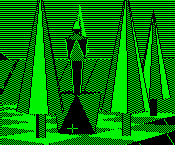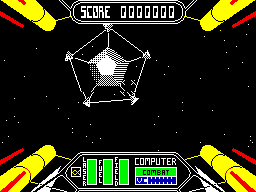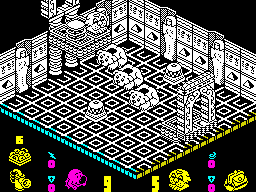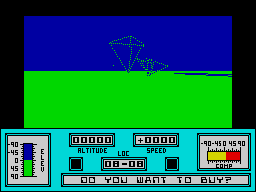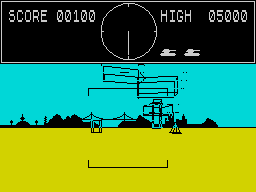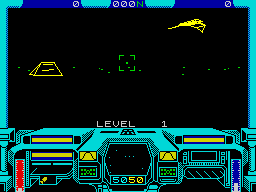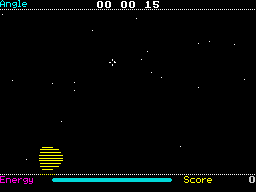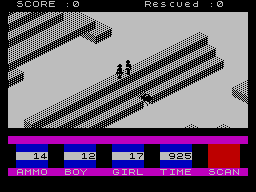INTO THE THIRD DIMENSION
Is 3-D ‘just another view’ or ‘the only way to do it’? The third dimension in games (the fourth, actually, because time is a dimension!) can often be mere gimmickry, but 3-D masterpieces have earned some of CRASH’s highest ratings ever. BEN STONE traces their history from 3D Ant Attack to Mercenary and talks to the programmers; MIKE DUNN joins him to present a screen-shot gallery of the 3-D world.
Also in this section: inside story on Incentive’s Freescape technique, which makes its debut this autumn in Driller.
ONCE UPON a time, in the early Spectrum days, ‘3-D’ prefixing a game’s name (3D Ant Attack, 3D Lunattack) or the infamous quote ‘amazing 3-D graphics’ printed on an inlay would guarantee an increase in sales of almost 30% (CRASH Mail Order estimate). Many game producers jumped onto the 3-D bandwagon with their own idea of the extra dimension, and some so-called 3-D was little more than two-dimensional graphics with extra shading or bas-relief that could create an illusion of physical depth but added nothing to the gameplay.
In May 1984 Hewson Consultants, as Hewson was then known, became concerned with this pseudo 3-D software, and organised a press conference on the use of 3-D. At the gathering Steve Turner, author of Hewson’s very successful Seiddab trilogy, gave his definition of 3-D:
‘The player should, for the majority of the time, appear to be immersed in a dynamic playing area. There should normally be some approximation to true perspective unless other sufficient strong three-dimensional cues are present.
‘This definition allows two main types of game to be classified as 3-D, In the first type the player is represented by a figure on the screen but his view is from a position above and outside the playing area. 3-D effects are generated by strong visual cues in the shapes and shading of the playing area. In the second type the player is not represented on screen but instead has an eyeball or cockpit view of the playing area. He can manoeuvre within the area and the 3-D effects are generated by perspective and parallax using a vanishing point.’ (This quote is taken from the feature on 3-D in CRASH Issue 6.)
It’s difficult to think of any games that differ from the two outlines above — it would be pretty hard to conceive and produce a 3-D game that didn’t fall into one of Turner’s categories.
Some games, like CRL’s Room Ten (imagine it as wireframed Ping-Pong in a box; author Pete Cooke later did CRL’s Academy and Nexus’s Micronaut One) and Electric Dreams’s I, Of The Mask (marvellously-shaded vector graphics with a character running in the centre of the screen but viewed from a cockpit) have combined the two types of 3-D to nicely disconcerting effect.
A VOYAGE ROUND 3-D
As well as two distinct types of 3-D presentation, there are two distinct types of 3-D game. You’d expect something with a cockpit view of vector graphics to be a shoot-’em-up or flight simulation (3D Tank Duel, Fighter Pilot); a forced-perspective game with the character on the screen (bird’s-eye view) would probably be a puzzle-solving, collecting-objects maze type of game (Knight Lore, Ant Attack, Nosferatu).
There are, of course, some exceptions, like Postern’s 3-D Deep Space (written by Mike Doomdark’s Revenge Singleton), which used a technique very similar to that used in the 3-D pages of this very CRASH.
And Steve Turner comments ‘I hate the typecasting of games’; there are, after all, only a few different ways of seeing the screen so it’s meaningless to liken one game to another just because they both display action the same way.
Pete Cooke says the typecasting is ‘something that I’ve tried to avoid — there’s certainly room for totally different types of games to look similar.’
PRO AND CON 3-D
The best thing about 3-D games, for the CRASH reviewers at least, is the great atmosphere they create. Everything is so much more believable because it looks closer to real life.
Steve Turner again: ‘The extra dimension enhances games, and if it’s done well enough it creates an illusion of reality in the screen, which is something I’m into creating.’
This illusion of reality is maximised when the player has a first-person or cockpit view from the F-16 or Super-Dooper Battle Tank they’re controlling. As Pete Cooke says, ‘first-person perspective is the best way of doing things on 8-bit machines because you’re actually in the game.’
Backing him up, Realtime’s Ian Oliver reckons first-person perspective is so popular because the Z80 processor is very good at vector graphics, it’s very fast, and speed is the main ingredient of a good shoot-’em-up. ‘That’s why nobody’s used anything like Freescape (see the article in this section) before, it’s not that it’s very difficult to do or anything, it’s just that no-one has thought of a decent game plan to put aroupnd the sluggish technique.’
But Sandy White, renowned as the first programmer to write a real isometric-perspective 3-D game (3D Ant Attack), insists ‘Freescape has done well to compete with the 16-bit machines’ in the complexity of its solid 3-D world. White is a sculptor as well as a games programmer, so it’s no surprise that his limited, but careful, output has all been 3-D. He says ‘3-D is the only way to do it...’
That’s not a sentiment which Graham Stafford, half of Design Design, agrees with entirely. ‘3-D is good when used properly,’ says Stafford, ‘but it’s not essential, far from it. Sometimes it’s just a trick.’
Steve Turner, the man who offered those early definitions at the Hewson Consultants press conference, looks back on a trick’s history: ‘At the start a lot of people thought that 3-D was a passing phase. Over the years I think that it’s more than proved its usefulness in the computer game. I doubt that 3-D games will drastically improve on the Spectrum from now on, though — most of the programming techniques possible must have been used by now...’
And while David Llewellyn, the other half of Design Design, muses that ‘it’s nice to present puzzles that can only be seen in 3-D,’ he points out that ‘you can represent any 3-D in 2-D if you try. It’s just a view, you’re always looking for another view.’
READING UP THE THIRD DIMENSION
GIVEN AWAY FREE with Design Design’s 3-D Dark Star was the ‘teletext’ fun package Spectacle. It mentions a university textbook, Principles of Computer Graphics (published by McGraw-Hill), which covers the rudiments of 3-D graphics. Says Design Design’s Graham Stafford: ‘It’s as boring as hell, but it explains everything that you want to know about 3-D graphics.’
FREESCAPE — ALL THE SCREENS YOU CAN EAT!
THERE ARE 20,000 billion screens, give or take a thousand billion, in Incentive Sofware’s Driller (that’s 20,000,000,000,000,000, or is it 20,000,000,000,000 these days?)
There are just three spatial dimensions in Driller, but it simulates movement in the real 3-D world better than any game yet. You can go over and below objects, crawl round the back of them, see things from any angle, and look over your shoulder at the futurescape through which you’ve passed.
Driller, featured on last month’s CRASH Sampler, introduces the Freescape technique which Incentive’s Major Developments team has worked on for the last 14 months. The walk-through filled three-dimensional graphics display every detail (of admittedly undetailed screens) in real perspective. It’s just like being there, if a bit like being there on a pogo stick — on preview copies the movement from one view to another is jerky.
Driller has a straightforward enough space scenario: dangerous gas is building up beneath the moon’s surface, so the player must locate the pockets of gas and drill holes in exactly the right places to allow the gas to diffuse.
But the real story is the technical one. ‘When the Freescape idea was conceived,’ says Incentive’s Ian Andrew, ‘several programmers approached turned down the opportunity to be involved, saying it couldn’t be done. Well, it has!’
The 3-D Driller world was designed in two dimensions using a customised programming utility; three dimensions were produced by combining a plan and side and front elevations of each object.
It was fine-tuned using the Freescape Editor, with which the Major Developments team can alter graphics and gameplay from within Driller’s 3-D environment.
The data is terrifically compressed, ‘enabling massive environments to be available in a single load,’ Andrew points out.
To give the 3-D effect, ‘all visible objects are priority-sorted, ie it’s decided which objects obscure others,’ he explains, ‘and drawn solidly, using an unorthodox filling technique for speed.’
Freescape is ‘probably the most advanced program yet written on 8-bit machines, featuring an incredible amount of maths,’ enthuses Andrew. And he reckons ‘it’ll take a good player a month, an average player half a year to a year’ to complete the game.
The November Spectrum release from Incentive will cost £14.95 (that price includes a novella and a 3-D mapping model), and a 16-bit Freescape is scheduled for March 1988.
BARNABY PAGE
